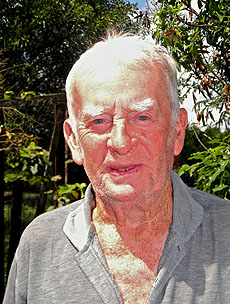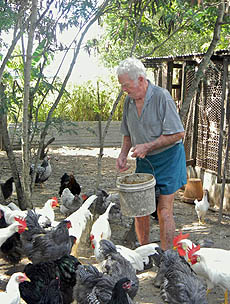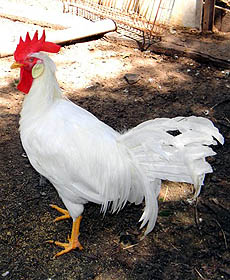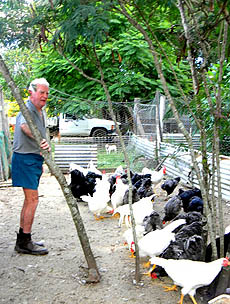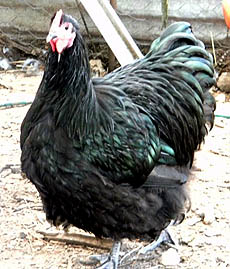Recognising success
Clive (and Dos) Claus lives in Rosewood, Queensland. He has been a prominent member of the Australian poultry scene for many decades—as a successful and influential breeder and exhibitor, as a judge and as a mentor to others.
He and Dos have also made a huge contribution to the organisational side of poultry, as senior members of the Rosewood Poultry Club. Clive has been the President, Secretary or Treasurer of the club for over 50 years. He holds a lifelong love of all animals, in all forms and has kept almost every breed of domestic poultry available in the country, taking many of them to the pinnacle of quality. This is his story.
How long have you had poultry and what got you started?
I've always had birds around and I've had a lifelong love of them. I've kept pigeons since I could walk. My dad bought me five pairs of budgerigars when I was 7-years-old and people came from miles around to see them. They were amongst the first to come into Queensland at the time. I bred them for many years and from that I learned a lot about breeding.
I've had Muscovy ducks since I was a kid too. I keep some of my ducks now on the family property—it's had Muscovy ducks on it for 100 years. My grandmother (on my mother's side) kept black Orpington fowls. My grandfather (on my father's side) kept ducks and Leghorns as well. He used to load up his sulky with birds and take them off to the local shows. When I started out with Leghorns they weren't my grandfather's, they were long gone. I started with others and got birds from John Gibson to improve my bloodline.
Les Blake was an early mentor for me – he was my brother in law. I was always going over to his property. He kept many breeds and taught me a lot about poultry husbandry. Les had a good strain of White Wyandottes and I still have birds from this strain. Les got me started in showing birds. The first birds I showed were Black Rosecombs, Black Pekins and OEG Duckwing Bantams. I received these birds from Les and they were top quality.
You've judged all over Queensland and northern NSW and at the Melbourne, Sydney and Adelaide Royals. What's your technique as a judge?
I used to judge 500 birds in a day at a show. When I judge I don't talk. You have to concentrate and you need to keep your mind on it. I say to the steward that I'm not going to talk. You can't be talking to people behind you and concentrating on a bird at the same time. When you've finished the class you can say a couple of words then.
First, I look at the bird in the pen. Don't upset it and don't poke it. Not all birds need a judging stick. You want the birds quiet. If the bird is not quiet I won't take it out of the pen. Get the bird out, check it – check the breastbone to see if it's straight, check for crooked toes, pull the wings out to check for broken feathers. You have to feel the bird.
Know the standard. Type is the main thing, then things like colour and headgear.
You've kept a huge variety of breeds. What are you focusing on now?
I've got black and blue Orpingtons, White Leghorns (a magnificent bird), Columbian Wyandottes, Silver Laced Wyandottes, Plymouth Rocks (dark barred) and many varieties of bantams. My strain of White Leghorn bantams have always been the best laying birds I have ever had in my yards.
I have kept many varieties of ducks—Indian Runners, Khaki Campbells, Mallards, Call Ducks, Rouens, Aylesburys, Elizabeths and Cayugas.
I specialise in Pekins now. I've bred them for over 50 years. I started out with black, blue, white, cuckoo and mottle. That's all you could get then. I've put a lot of work into breeding new colours in Pekins. I took the first Brown Red and Birchen Pekins to the Brisbane Royal. People loved the new colours, although judges tended to give the top awards only to the Black and Whites.
In those days the Pekins shown were smaller than the ones we have now with a lot less feather on them. The infusion of birds with the long feather gene has led to a vast improvement in the Pekin breed. I am very proud to say I have had much to do with the improvement of them. The only problem is when breeders use these heavily feathered birds together for several years which results in basically "bags of feathers" rather then Pekins as we know them. Overuse of these excessively feathered birds will be to the detriment of the breed.
Buff Pekins are a challenge. The best bird I ever saw was a Buff Pekin I bred. I took it to the Brisbane Royal and it got a second in a class of three. I can laugh about it now!
What are the main challenges facing the poultry fancy?
A lot of breeds have slipped. Local government laws are against people having poultry. It will kill poultry if it doesn't change. When I began showing most exhibitors lived in town and no-one ever bothered them over crowing roosters.
In other countries they let people have fowls in a community building outside the town. This allows people to maintain this wonderful hobby that helps to keep the mind active and allows you to enjoy life even more. It's a wonderful relaxation to have a few bantams and waterfowl.
Where I am I have plenty of space, though, and I'm able to keep whatever I like. I've carried a thousand birds at times. I'm cutting down a bit now though. I now rear about 300 to 400 chickens a year.
What are your methods for show preparation?
Birds I'm preparing for show are kept in training pens with pine shavings on the floor. Big poultry breeds need a good sized pen at least 700mm x 700mm to be able to handle them and get them to settle down. With a lot of handling you get them quiet in a short space of time.
When it is starting to get dark I take the birds out of their pens and handle each of them, this helps to make them quiet. I wash the birds in warm water, with a bit of Martha Gardener wool wash. Rinse them in warm water to get the soap off. It's very important to get the soap out. Put them out on the lawn to dry in small wire cages.
These days some people use a blowdryer – you can use that if the weather is wet. Some birds I don't wash, like gamefowl.
What do you feed your birds?
I give them mash once a day or pellets. If it's mash I mix in milk powder and I only use a good quality mash. I give them some wheat and corn. The Pekins get some French millet. Chicks get a little bit of French millet in their mash a few times a week and they love that.
If you want your birds to do well you need to look after them well, feed them well and care for them well. Use a good quality feed.
What's your approach to housing your birds?
I have a number of different types of pens which are needed to house and raise birds at different stages of the year and for varying purposes (such as housing excess males, rearing chickens at different ages, spelling pens for extra females).
When rearing chickens you have to keep them warm and you mustn't take them away from the heat too early. If you do and you get a cold snap then coccidiosis can hit very quickly. Don't crowd too many chicks together even if you have a big brooder as this will only lead to trouble.
One thing I have learned is that artificial lighting on the growing progeny needs to be kept to a minimum. Extra light at night over-stimulates them and leads to many problems and vices. I use ceramic brooders which have a heat bulb but no light.
When birds are developing from juvenile to maturity I like to give them access to open, grassed runs with shady trees. I generally run them in groups of 34 to 40 in a run of about 1000 square metres, with a shed in the middle for roosting. Most of my poultry are kept in good sized pens with deep litter. Shade plays an important part in all these pens.
I never have problems with feather pecking when raising birds in large open runs. Space is an important consideration in raising any fowl.
You've mentioned that you've had quite a few valuable mentors throughout your poultry career. What makes a good mentor?
A mentor can help a person buy good fowl. A mentor can teach you how to handle the birds and how to get them quiet. You need to learn how to handle and feel the bird, what its structure is like. A mentor can teach you about the standard and about type.
I could name a dozen people I've learned from. Athol Giles, Athol Pengilly, Les Blake, Pat Birchall, Arthur Harwood, Ian Benson... I've made a lot of friends.
I learned a lot from talking to master breeders at shows. People who gave me tips in the early days on what to put together in the breeding pen. I took their advice and tried it out and their techniques worked.
Someone I'm mentoring, Damien Frith, he's judging at the Nationals in Canberra in June. I won't get to the Nationals this year. I got there for the 2004 show. I was wearing a big coat and the first bloke I met asked if he could buy it. It was cold.
What are your tips for someone new to exhibiting but wanting to start out?
Buy from a reputable breeder. Some people go along to an auction to see what they can find but I would recommend seeking out a respected breeder. Good birds aren't cheap. Expect to pay for good birds. Buy for breeding, not for showing. Start with an easy breed. An easy breed is a quiet breed – like the Orpington and many others in softfeather. Kick off with just a couple of breeds and don't be afraid to ask for advice.
The trick is knowing how to develop and maintain good breeding lines as the years go on. You need to strive to maintain vigour and quality. This involves a lot of trial and error but that is the way to learn. Don't be afraid to mix and match colours to achieve your desired aim. Only breed from your best stock. Just because you have six females doesn't mean you have to breed from them all. Stick with the old saying of "breed a lot from just a few".
People starting out should also develop a good library. Read as much as you can. Get poultry journals going back as far as possible. Read about all the finer points of the breed. These days people can't always keep large numbers of birds or breeds, but you can read about them.
